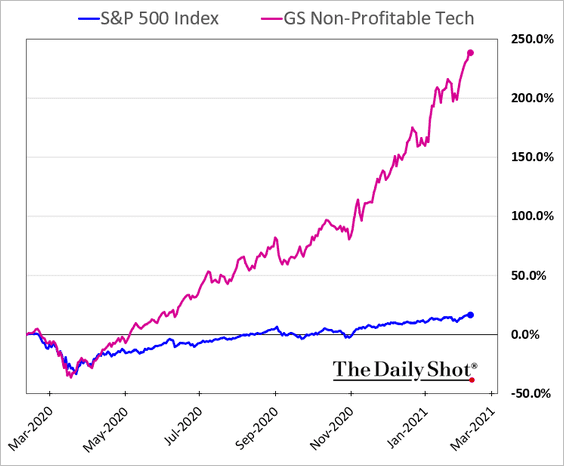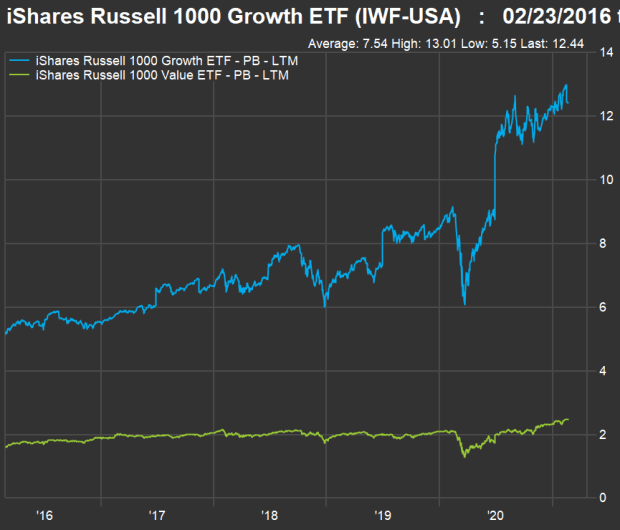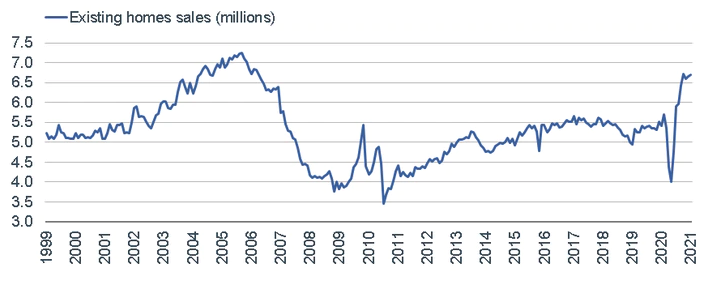1. Two Charts Summarizing Speculation in Markets


The Daily Shot Blog
2. XME CHART BREAKOUT
XME Metals and Mining ETF

©1999-2021 StockCharts.com All Rights Reserved
3. Videogamers ETF’s +100% During Covid.
ESPO ETF-Gamers and Esports

©1999-2021 StockCharts.com All Rights Reserved
4. Russell 1000 Growth Price to Book Grew from 5.2 to 12.4 in 5 Years…Russell 1000 Value 1.5 to 1.6 in Same Time Frame
For five years, the Russell 1000 Growth group has more than doubled the return of the Value group. The Growth group’s forward P/E ratio has increased to 30.9 from 16.7, while the Value group’s forward P/E has increased to 15.5 from 14.4. The Growth group’s price-to-book ratio has increased to 12.4 from 5.2, while increasing to 1.5 from 1.6 for the Value group.
So the valuation ratios are up significantly for both groups, but there is no comparison in degree — Growth has been a runaway success and as a group appears to be expensive. The Growth group’s numbers are also distorted by its cap weighting. The top five stocks in the iShares Russell 1000 Growth ETF make up 33% of the portfolio, with the largest holding, Apple, weighted 10.7%. In the iShares Russell 1000 Growth ETF, the top five make up 10.5% of the portfolio, with the largest holding, Berkshire Hathaway Inc. BRK.B, +0.23%, at 2.5%.
And finally a comparison of the movement of their ratios of price to book value.

(FACTSET)If you think it’s time to shift to value stocks, here are Wall Street’s favorites
By Philip van Doorn https://www.marketwatch.com/story/if-you-think-its-time-to-shift-to-value-stocks-here-are-wall-streets-favorites-11614094400?mod=home-page
5. Stocks Related to Bitcoin…OSTK +850%
Bitcoin’s surge has also done wonders for stocks that were left for dead. Overstock, for instance, surged 850% from $2.50 to $85 over the past year, including a 77% gain this year. The company has built a portfolio of blockchain and crypto-companies under its Medici Ventures division. It now plans to convert that unit into a limited partnership called Pelion Venture Partners Fund.

©1999-2021 StockCharts.com All Rights Reserved
6. 50% of Americans Vaccinated by June and 70% by September.
At the current pace of vaccinations, 50% of the population in the US could have the vaccine by late June and 70% by the start of September. Of course, the daily pace of vaccines may accelerate further as logistics improve and additional vaccines get FDA approval.

An estimate by Raymond James seems a bit optimistic – suggesting that 300 million people in the US will be inoculated by June in their base case scenario, with earlier herd immunity potentially being reached by April-May. In the most pessimistic scenario, herd immunity will be reached by September.
Risks of High Equity Valuations Present Tactical Opportunities-by Arturo Neto of The Outsourced Chief Investment Officer, 2/23/21
7. Housing on fire…V-Shaped Recovery
Existing home sales have clearly staged a V-shaped recovery, as seen below. There were only about a million homes for sale in the United States at the end of January—a 26% drop from a year ago. At the pace of current sales, there is now less than two months’ worth of supply, which is the lowest on record since 1982. This lack of supply continues to push prices higher, with the median price of an existing home sold in January at nearly $304k—a 14.1% year-over-year increase, and the highest January price ever recorded.

There was one blemish in recent data. Housing starts fell much more than expected in January; while the prior two months were also revised lower. However, building permits—which lead housing starts—jumped more than 10%, to the highest level since May 2006.
Stronger Permits Bodes Well for Starts Rebound

Source: Charles Schwab, Bloomberg, as of 1/31/2021.
EleVation: Some V-Shaped Economic Data to Cheerby Liz Ann Sonders of Charles Schwab, 2/23/21
8. Most of the U.S. is Uninhabited
Food For Thought: Uninhabited parts of the US (green): The Daily Shot Blog

https://dailyshotbrief.com/the-daily-shot-brief-february-22nd-2021/
9. 25% of Americans Get News Strictly from One Political Leaning Source.
Overall, 24% of Republicans and Republican-leaning independents

10. Find Purpose and Productivity with Your Core Values
We all have goals and dreams. Big things we want to achieve, people we want to become, and new mountains we hope to climb. But why do we choose to do what we do? More often than not, the whys behind our goals all boil down to one thing: our core values.
Our values are the set of beliefs that underpin our choices. When we do things that align with our core values, we’re more likely to feel fulfilled. In fact, tying our goals to our core values can lead to an increased sense of being productive and living more meaningful lives. Our values play a huge role in our emotional well-being, which effects how we interact with those around us.
However, when we don’t understand our core values and set goals that line up with them, it can create dissonance. Things won’t feel right; we’ll get bored or feel like we’re spinning our wheels, and our goals will never seem to make us happy. All of these feelings result in a lack of ambition and motivation. If we want to place our best foot forward, we have to first identify our values and bring them into alignment with our actions.
Dig Deep and Find Your Inner Schwartz
In psychology, one of the most commonly used identifiers of core values is the Schwartz Theory of Basic Values. According to this theory, values encompass a broad range of ideas and concepts:
Values are beliefs. And, when those values are stimulated by actions that align with them, we feel happier.
Values tie into goals. In other words, our values help spur us into that very same action. For example, if justice is a core value, we’ll naturally tend to create goals that align with that idea.
Values transcend actions or situations. That means that our values aren’t something we compromise on, or only have when it’s convenient. They’re constant.
Values are standards and criteria. This means our values aren’t just something we think, they’re standards and ideals we hold ourselves and others to.
Different values have different levels of importance. No two values necessarily hold the same level of importance in our lives. Which means…
The importance of those values guides what actions we take. So, when two values are in conflict with one another, for instance, whichever one is more important or has more weight is what will guide our actions.
From there, Schwartz’s Theory breaks down all values, regardless of culture or time, into ten basic categories:
1. Self-Direction: correlates with independence, creativity, and exploration.
2. Stimulation: craving the new. Ties into excitement, novelty, and challenges.
3. Hedonism: things that correlate to pleasure or gratification for oneself.
4. Achievement: success through showing your competence.
5. Power: tied to social status, prestige, and control.
6. Security: relates to ideas of safety, harmony, and stability.
7. Conformity: restraining oneself and complying with societal norms.
8. Tradition: breeds goals around respect, commitment, and older ideas.
9. Benevolence: making sure you take care for or are concerned for the welfare of those you know.
10. Universalism: a deep desire to understand, protect, and promote the welfare of all.
When Your Values and Goals Don’t Align
According to this theory, we all have our own assortment of these ten underlying values. Maybe you’re an overachiever, for example. Someone who enjoys meeting exacting standards, being at the top of your career or social ladder and living a life of luxury. So, your goals are all around your career or reaching certain social status markers: getting that new promotion, buying a luxury automobile or winning an award.
If that’s the case, then two of your core values are achievement and power. Within this model, those values complement one another. You value personal success as well as personal control or advancement in social status.
Whatever your values are, whenever they align with our goals, we’re more motivated to achieve what we set out to accomplish. But when they don’t, we become less happy and productive.
For instance, if your core values revolve around self-direction and universalism, you probably wouldn’t enjoy a stoic, corporate job that’s steeped in tradition. You may do better if you set a goal to start your own business—or even better—one that helps empowers its employees to advance their own goals.
What wouldn’t necessarily benefit you, is doing something that compliments one value, but contradicts the other. Like, in the case of the self-directed universalist—becoming a solo entrepreneur with no altruistic or charitable end. Again, when we tie goals to ideas that go against or compromise our values, we’re less likely to reach them.
These ideas connect into something we’ve covered before: self-determination theory. (Not to be confused with self-determination as a value. I know, a lot of self-determination is happening today.) A large part of this theory resolves around the idea of autonomy.
In this case, autonomy is the degree to which we actually want to do what we’re setting out to do. Tying our goals to our values makes us more committed to achieving them, because they support things we already want to do. We get a psychological boost when we achieve them, are more likely to participate in activities tied to them and remain steadfast in trying make sure their realized.
Identify Your Values
If you find your productivity lacking, don’t enjoy what you’re doing, or simply want to reevaluate the things you want – take a moment to consider your core values. What are they? Are they in conflict with your goals or other aims?
It’s safe to say that most of us haven’t gone through the exercise of identifying our values before. Like boundaries, sometimes we don’t know that they exist until we cross a line. You might be one of those people that has no qualms with waiting to get zapped before realizing what your limitations are. However, we’re all better served when we know what challenges we face so we can meet them head on. It’s imperative, to make sure you understand the values that underpin your decisions.
Tools come in handy when trying to figure out our values. Products like our value deck and systems like the Schwartz Theory not only help us understand ourselves a little better, but they also help others understand us as well. (And in the case of the value deck, they can make it a little fun, too!)
With all of your options laid out in front of you, either in the form of cards or as a list like the ten listed above, ask yourself some tough questions. Which speak the most to you when you think about them? Which values do you feel most drawn to, or think you call on most in your daily life? Write them all out.
Next, list out your goals for the year. If you find that some of your goals have lagged or simply just aren’t working out – ask yourself if it’s because they don’t match up with what you consider to be your core values.
If not, that’s okay! Knowing what some of your values are can help you set new goals more effectively. For instance, maybe taking another class this year to learn about art was only a passing fancy. But you know that some of your core values are benevolence and security. Instead of flexing those art skills, try setting a goal around spending more time with family or doing something to help your community, like volunteering. That way, your goals are more clearly tied into the things you love doing, you’ll create less internal conflict, and you’ll be more likely to succeed.
When you know your values, the Schwartz will always be with you.
https://www.the1thing.com/blog/the-one-thing/find-purpose-and-productivity-with-your-core-values/
Lansing Street Advisors is a registered investment adviser with the State of Pennsylvania..
To the extent that content includes references to securities, those references do not constitute an offer or solicitation to buy, sell or hold such security as information is provided for educational purposes only. Articles should not be considered investment advice and the information contain within should not be relied upon in assessing whether or not to invest in any securities or asset classes mentioned. Articles have been prepared without regard to the individual financial circumstances and objectives of persons who receive it. Securities discussed may not be suitable for all investors. Please keep in mind that a company’s past financial performance, including the performance of its share price, does not guarantee future results.
Material compiled by Lansing Street Advisors is based on publicly available data at the time of compilation. Lansing Street Advisors makes no warranties or representation of any kind relating to the accuracy, completeness or timeliness of the data and shall not have liability for any damages of any kind relating to the use such data.
Material for market review represents an assessment of the market environment at a specific point in time and is not intended to be a forecast of future events, or a guarantee of future results.
Indices that may be included herein are unmanaged indices and one cannot directly invest in an index. Index returns do not reflect the impact of any management fees, transaction costs or expenses. The index information included herein is for illustrative purposes only.